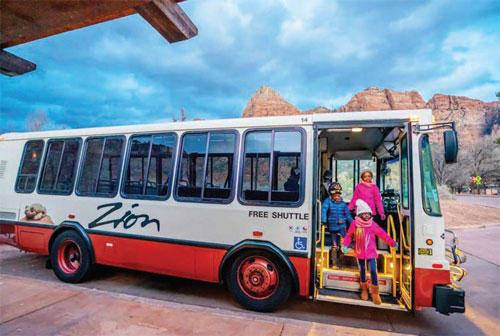By Brice Wallace
A project aimed at bringing electric shuttle vehicles to the east section of Zion National Park is being seen as key to helping not just transportation but economic development there and in surrounding areas.
Utah Clean Cities last year was awarded a U.S. Department of Energy grant to test electric shuttles that could climb and descend the switchbacked Highway 9 and pass through the Mount Carmel Tunnel without temporarily closing the tunnel, serving as the first step of a modernized transportation system in the region.
The EVZion three-year project, boosted by the $780,000 federal grant, is designed to demonstrate a small-scale, environmentally sound, zero-emission electric vehicle shuttle system through the east entrance of Zion. The project would prove the viability of electric vehicles in a rugged environment with extreme temperature variations and difficult road conditions in Southern Utah and could then be scaled and deployed in other parks throughout the U.S.
“The entire Department of Energy program is watching this,” Tammie Bostick, executive director of Utah Clean Cities, told the Governor’s Office of Economic Development (GOED) board during its March meeting. “This project is designed to pilot, scale and replicate in other national parks.”
Currently, propane-fueled shuttles used elsewhere in the park lack the power to climb the 11 percent grades and are too large to negotiate the 45 hairpin turns in the areas near the tunnel. The tunnel itself is too small for two oversized vehicles heading different directions, leading to 33,000 times last year when traffic moved only one direction. Bostick said that equated to “19 minutes every hour that you could actually pass through the tunnel unhindered by a large vehicle.” The smaller electric shuttles wouldn’t have that problem, she said.
“Two oversized vehicles cannot enter that tunnel and pass one another at the same time,” she said. “Our shuttles should be able to pass each other in the tunnel.”
The electric vehicles, with a 120-mile range, likely will begin their demonstration by the end of the year.
“People will say, ‘Well, open the tunnel, make the roads bigger.’ You can’t. It’s a national park. It’s a legacy piece. The tunnel will remain the same, the roads will remain the same,” Bostick said.
Even without serving the east side, Zion’s shuttles accommodated 6.8 million people last year. “Basically, it becomes its own city, its own transportation system, like no other in Utah, every day, especially in busy times,” Bostick said, adding that more than 1 million park visitors entered through the east side last year.
The aim with electric shuttles is to improve the movement of people throughout all of the park, thereby disbursing large crowds in any one area, and provide them with a better park experience.
“Tourists have made it very clear to the national park … they love being shuttled. They want that system. No one wants to drive up that back end of east Zion in a rental car,” Bostick said.
When fully developed, the shuttle system would be a key element of an improved east-side entrance to the park and improve connectivity between Zion and Kane County.
“If we aren’t ahead of this, then we’re behind it,” she said. “Right now, we’re 20 years behind in the park in building infrastructure and we’re 20 years behind in building out the shuttle. So it needs our attention, it needs some practical solutions, and we feel like this is the first step in the right direction.”
Bostick said park visitors and governments in that area want a futuristic transportation system. “People want it, the park needs it desperately, and we’re going to solve for it with these types of projects and programs,” she said.
Jerry Oldroyd, the GOED board chairman, said such a system is an important economic development objective for Iron, Kane, Washington and Garfield counties.
“They look at this as a way of increasing tourism, also disbursing the crowds and also ultimately creating a transportation system to Cedar Breaks, Bryce and others,” he said. “This is a major economic development issue for rural Utah.”
The near-term task is coming up with a 50-percent match, or $350,000, from local sources that is required for the federal grant. Bostick asked GOED to help identify sources for that local match. Oldroyd suggested local initiatives and also requesting funds from the Legislature.
Board member Stephen Neeleman said the electric shuttle project could propel Utah as “a giant leader” for the nation, helping figure out ways to solve problems related to air quality, noise, pollution and overcrowding in national parks.
“This has become a potential model for national parks,” Oldroyd said. “This is something that has a great deal of visibility nationally, both at the federal level and other states. It’s very, very important for our tourism.”








